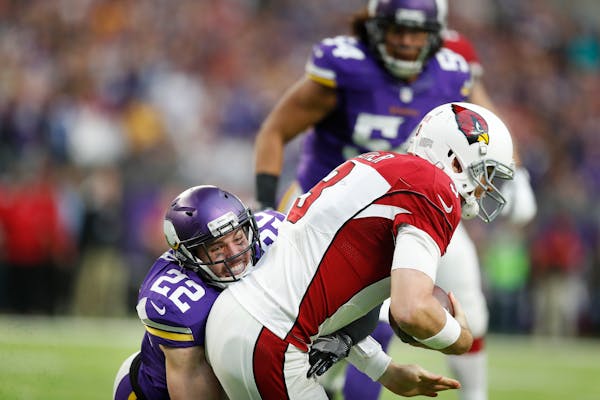A busted coverage created the Vikings' biggest offensive gain in nearly 500 plays.
Jerick McKinnon had half of the Ford Field turf to himself when he took a short catch for 41 yards during Thursday's loss in Detroit. The play came easily for McKinnon, a sharp contrast to the offense's season-long struggle to pick up big chunks of yardage. That has left quarterback Sam Bradford pondering how the Vikings can remedy that.
"We've got to find a way to create more explosive plays," Bradford said. "However we do it, we've just got to figure out a way to make sure that it happens."
The Vikings gained only 8 yards on the ensuing three snaps in Detroit and kicked a short field goal, a more appropriate encapsulation of their current plodding play. Their four plays of 40-plus yards this season are fewer than any other team but Houston (three).
Bigger plays certainly would help cover up other issues for an offense averaging just 19.8 points per game.
"Some of it is the design of the play," coach Mike Zimmer said. "Some of it is trust. Some of it is guys getting open. There's so many different things involved there."
Bradford was already one of the NFL's short-throw leaders under former offensive coordinator Norv Turner. But since Pat Shurmur stepped in as the interim play caller, the Vikings have often sacrificed even more depth and yardage on their routes for fewer hits on Bradford — done by quick throws in an effort to aid their replacement tackles.
Their lackluster running game, averaging an NFL-low 2.8 yards per carry, hasn't helped set up plays for Bradford and his receivers. Shurmur has leaned away from calling many runs, instead trading carries for more short throws.
As a team, the Vikings have topped 100 rushing yards only once (104 vs. the Giants).
Play-action passes have fallen by the wayside, Bradford said.
"Whether that's mixing in more of our play-action game, which we've kind of gotten away from," Bradford said. "We're trying to create some of these plays with some deeper-route concepts; that's one way."
An ineffective ground game shouldn't impact how fake handoffs could help the Vikings find more space downfield, according to Bradford.
"If you talk to any defensive coach in the league, each week they know that they've got to shut down the run," Bradford said. "So, they still do have to respect the play-action."
In general, the Vikings offense doesn't take many downfield shots, but Bradford especially kept his trajectory low in Detroit, where only two of his 37 attempts traveled at least 10 yards through the air. That game plan puts the onus on receivers to break tackles and create after the catch.
"I think after last week, we realized that we've got to be a little more balanced in how we go out there and do that," Bradford said.
Having more trust in his pass protection is one factor, Bradford said, though holding onto the ball for deeper routes puts him at greater risk. He was hit 19 times in a loss to the Eagles, when he attempted 11 passes of at least 10 yards downfield. Protection has improved with quicker throws, but production remains sporadic.
''I think the offensive line did a good job on Thanksgiving," guard Alex Boone said. "I think Sam only got hit three times."
The Vikings' reliance on a quick-hit passing game has the potential to create some predictability issues with defensive backs breaking on short routes. Recently, Bradford has been baited into two game-ending interceptions by shallow coverages in Washington and Detroit.
"It really gets to the point where, 'OK, they're throwing so much quick stuff that eventually they are going to throw something deep,' " Lions safety Glover Quin told reporters after Thursday's game. "They never did, so it was actually kind of lonely back there."
Bevy of defensive playmakers are available in Round 2 of the NFL draft after historic offensive run
Twins bring momentum on road despite Angels Stadium struggles

Neal: McCarthy mania sweeps through Vikings draft party

Pretty much a must-win Game 3 for Suns as series moves to Phoenix

